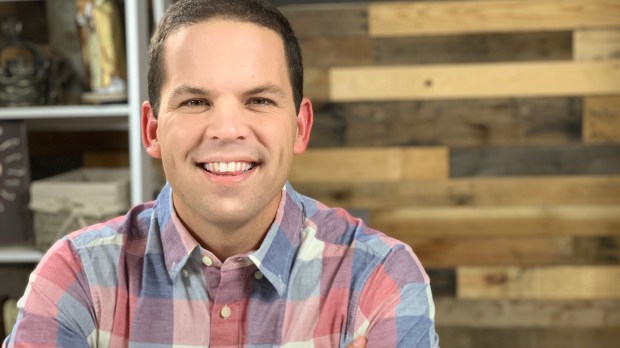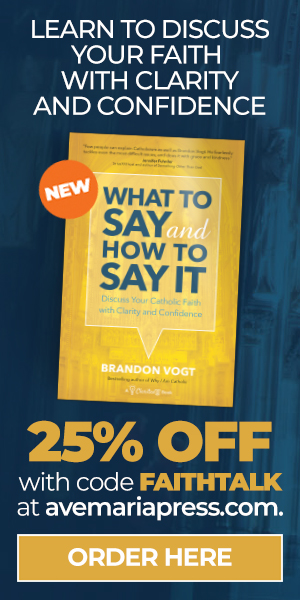In this straightforward and practical book published by Ave Maria Press, Brandon offers essential tools for articulating even the most contentious aspects of our Catholic faith with clarity and confidence.
1. Brandon, what inspired you to write “What to Say and How to Say It”?
A few years back, I sent a survey to around 60,000 email followers, asking them to share the number one thing they struggle with in their faith. Predictably, a number of people mentioned difficulty in prayer, or a loved one who has left the Church.
But far and away, the most popular answer was some version of, “The culture is trying to squeeze the faith out of me. My Catholic beliefs are increasingly out of step with our world, which means I’m often embarrassed to discuss my faith, or even identify, publicly, as a Catholic, whether at work, school, or among my friends. I’m worried they’ll think I’m a bigot or close-minded, and if they push back against my views on marriage, sexuality, science, or religion, I just have no idea what to say. I’m so afraid.”
I received hundreds of variations of this answer. It confirmed for me that lots of people love their Catholic faith, and they find it true, good, and beautiful, but they’re increasingly nervous about publicly discussing it with others. They’re not confident; they’re scared.
After wrestling with this problem for some time, I finally hit on a solution. I found that our confidence about discussing any topic is directly tied to our clarity about it. We know this from experience, with other subjects. Think about it: the topics you’re most clear about are those you’re least nervous about discussing, right? If you knew everything about baseball, inside and out, you would never get nervous discussing baseball with a friend, even a friend who disagreed with you about this or that facet. Nothing would rattle you. You’d find those conversations fun and invigorating because you’re totally clear about what you believe.
The same holds for religion. We need to get Catholics clear about the faith, especially hot-button moral issues, so they’ll be brimming with confidence, no longer tongue-tied or afraid.
That’s exactly what this book does. It looks at seven of the most controversial topics, the ones that terrify most Catholics, and get them clear and confident so they can calmly discuss them with friends and family.
2. Who is this book meant for and what do you hope readers take away from “What to Say and How to Say It”?
This book is meant for any Catholic who gets nervous when topics like atheism, science, abortion, same-sex marriage, or transgenderism come up in conversation. It’s for Catholics who deeply love their faith but are leery about discussing it with people who strongly dislike Catholicism.
The main takeaway is confidence. Again, the more clarity you get about each subject—clarity about what you believe, about the main objections, and about how to answer those objections—the more confidence you’ll have. Clarity breeds confidence, and that’s what this book imparts.
3. In a society where relationships are often regulated by political correctness, how do you think this book can help Catholics better evangelize in our communities and in our workplace?
Notably, this book doesn’t just tell you the what of Catholic teaching. Lots of other books do that well, conveying what the Church teaches and why. But this book goes further, adding practical conversation strategies, hence the title: it’s not just what to say but how to say it.
For each chapter, you’ll find blueprints for how to navigate these tough conversations with grace and calm, so that you stay in the driver seat of each discussion.
4. What would you say are some “do’s” and “don’ts” when engaging in friendly debate or conversation about our Catholic faith?
The “do’s” and “don’ts” are different for each topic, but I’ll offer a few general recommendations.
First, offer more questions than assertions. This is the approach modeled by great conversationalists, up and down the centuries—everyone from Socrates to Jesus to Jimmy Fallon. Questions do a few things at once: they shine the spotlight away from you, so you don’t have to immediately defend your own position; they allow you to glean useful information about the other person’s view, so you can genuinely understand it; they convey respect for the other person since they imply you’re interested in what they think; and questions often cause the other person to self-reflect and perhaps reconsider previously unquestioned views. So, questions are the most important tool in your bag, and this book walks through a handful of specific questions you should ask that are especially powerful.
Second, aim for small wins. It’s unlikely that in one conversation you’ll convince another person that the Church’s views on marriage, sexuality, or any other hot-button issue are perfectly sensible. Your aim shouldn’t be to totally change their minds. Instead, you just want to move the needle a little bit. Perhaps your immediate goal is to just show how the Catholic view is rationally coherent and not arbitrary, that given a basic set of principles, it makes sense. Now, the other person might reject those basic principles, the ones on which the Catholic view depends, but the person can at least admit that if one holds those principles, it does indeed make sense. For many critics of Catholicism, this is a big step forward.
Finally, don’t get emotional. When hot-button issues come up, conversations often shed more light than heat. We get angry, loud, bombastic. We turn the discussion into a mano a mano showdown, to see who can destroy or eviscerate the other person’s view, forcing them into submission. But this doesn’t help. It might give you a temporary ego boost, but it does nothing in the long run. You must always stay calm, cool, and joyful, even when sharing unpopular views. And once again, to beat the same drum as earlier, this capacity only comes through clarity and confidence. Once you’re clear about your beliefs, you become confident. And once you’re confident, it’s easy not to get rattled and to resist the escalating emotions and rhetoric.
5. Is this book in any way a continuation of your award-winning book “Why I Am Catholic (and You Should Be Too)”?
Yes! My previous book, Why I Am Catholic (and You Should Be Too), was aimed at former Catholics, atheists, agnostics, and “nones,” those far from religion. However, I heard from a number of readers who said something like, “Well, I really enjoyed your book and I’m feeling drawn to the Catholic Church, but what about [insert controversial moral/religious view.]”
That’s what this book helps with. So, in some ways it’s a sequel, following up by addressing these prickly stumbling blocks. The first book made a positive case for Catholicism; this one offers a defense against criticisms.
It’s primarily aimed at Catholics, teaching them how to discuss these topics, but non-Catholics will find it helpful, too.
6. How does the content of your new book relate to your ministry, ClaritasU, and how it came to be?
ClaritasU emerged a few years back as an online training ground for Catholics who yearned to master these hot-button issues. ClaritasU revolves around a series of topical video courses. For example, we have courses on “Answering Atheism,” “Abortion,” “Transgenderism,” and more. I teach all the courses myself, and we have new videos each week.
More than 4,000 Catholics have joined ClaritasU and the results have been overwhelming. I regularly get emails from ClaritasU members who describe for me recent conversations in which they employed the tips and strategies they learned from a particular ClaritasU course, and how instead of feeling nervous, they felt calm and in control, like a wizened master—the Gandalf of conversations! Nothing could make me happier.
This new book is based on seven of our most popular ClaritasU courses, adapting them for print. But if readers want more, we currently have over 20 courses inside ClaritasU, which can be found athttps://ClaritasU.com.
You may purchase the book by clicking on the following links:
Ave Maria Press: https://bit.ly/2zyq2po
Amazon: https://amzn.to/3fHL6dJ
Barnes & Noble: https://bit.ly/2Wnh9Iz
A free downloadable discussion guide is available on the Ave Maria Press website at the link below: https://bit.ly/2AgWM73


